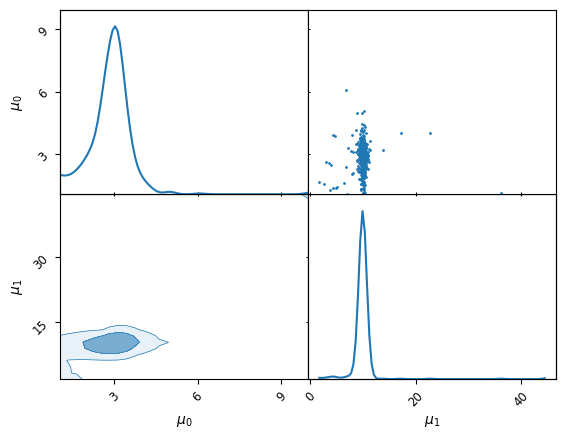Gaussian Process Regression#
Gaussian Processes are a non-parametric probabilistic modelling method that under some assumptions provide a flexible data model with hyperparameters that can be regressed to data in either an optimization or marginalization paradigm.
An extension of the usual parameter inference of kernel hyperparameters employed in GPR is to consider a Bayesian Model Selection of the choice of Kernel itself [KYHH24, SLR21].
We will use this problem to demonstrate implementation of a model that has combinatorial degeneracy in it’s parameters, and how to suppress this issue. Think sorted priors or forced identifiability transforms for those familiar with other popular NS implementations.
As an aside we use uv in this case to do package management, which can be useful if using hosted notebooks
!pip install uv > /dev/null 2>&1
!uv pip install --system tqdm numpy jax anesthetic tinygp tensorflow_probability git+https://github.com/handley-lab/blackjax@nested_sampling > /dev/null 2>&1
import jax
import jax.numpy as jnp
import tinygp
import blackjax
import matplotlib.pyplot as plt
import tqdm
import tensorflow_probability.substrates.jax as tfp
from blackjax.ns.utils import finalise, sample
from functools import partial
tfd = tfp.distributions
tfb = tfp.bijectors
rng_key = jax.random.PRNGKey(0)
print(f"Running example on an {jax.devices()[0].device_kind} GPU")
Running example on an NVIDIA L4 GPU
x_min = 0.0
x_max = 1.0
noise_level = 0.15
true_freqs = [3.0, 10]
x = jnp.linspace(x_min, x_max, 100)
def function(x, freqs):
return jnp.sum(
jnp.sin(2 * jnp.pi * x[:, None] * jnp.array(freqs)), axis=-1
)
rng_key, data_key = jax.random.split(rng_key)
y = (
function(x, true_freqs)
+ jax.random.normal(data_key, x.shape[0]) * noise_level
)
x_plot=jnp.linspace(0,1,300)
f,a=plt.subplots()
a.plot(x_plot,function(x_plot, true_freqs[0]), c="C1", label="basis 1")
a.plot(x_plot,function(x_plot, true_freqs[1]), c="C2", label="basis 2")
a.legend()
f,a=plt.subplots()
a.scatter(x,y, c="C0", label="Data")
# plt.plot(x_plot,function(x_plot, true_freqs[0]), c="C1", label="basis 1")
# plt.plot(x_plot,function(x_plot, true_freqs[1]), c="C2", label="basis 2")
a.plot(x_plot,function(x_plot, true_freqs), c="C0", label="Truth")
a.legend()
<matplotlib.legend.Legend at 0x7a7720a01a50>

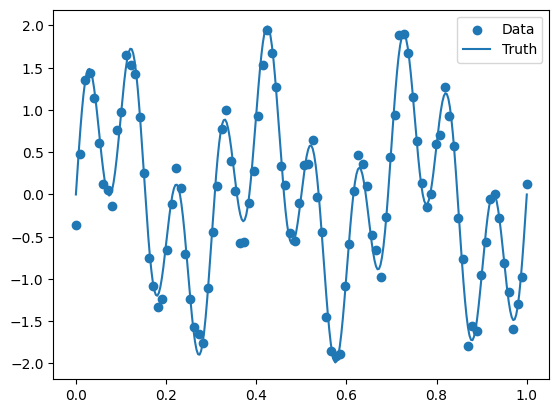
GP Likelihood and Priors#
We will use the tinygp library to provide the kernel and GP implementation, closely following the Spectral Kernel Tutorial on the tinygp docs. The Kernel function describing correlations on a length scale \(\tau\) is defined as,
Where we can identify a weight \(w\) being applied to a Gaussian in fourier space at frequency \(\mu\) and with a variance \(\sigma\). There are then \(N\times3\) hyperparameters to fit, where \(N\) is the number of degenerate basis functions we choose to paramaterize our distribution by. We will also introduce a global noise added to the diagonal of the covariance induced by the spectral kernel.
class SpectralMixtureKernel(tinygp.kernels.Kernel):
weight: jax.Array
scale: jax.Array
freq: jax.Array
def evaluate(self, X1, X2):
tau = jnp.atleast_1d(jnp.abs(X1 - X2))[..., None]
return jnp.sum(
self.weight
* jnp.prod(
jnp.exp(-2 * jnp.pi**2 * tau * 2 / self.scale * 2)
* jnp.cos(2 * jnp.pi * self.freq * tau),
axis=0,
)
)
def build_gp(params):
kernel = SpectralMixtureKernel(
jnp.exp(params["weight"]),
jnp.exp(params["scale"]),
params["freq"],
)
process = tinygp.GaussianProcess(
kernel,
x,
diag=jnp.exp(params["noise"]),
)
return process
@jax.jit
def loglikelihood(theta):
logl = build_gp(theta).log_probability(y)
return logl
Now we declare a prior for this process, where we will use a Uniform prior over a reasonable range of frequencies and a lognormal prior on all other parameters. It is convenient to use a structured joint distribution to do this, and we use tensorflow-probability for this in this instance. To tell the sampler how to translate to this structure from a flat vector we will use the inbuilt jax.flatten_util.ravel_pytree to get the reverse of a tree flatten, so should match any internals of the blackjax code.
fundamental_freq = 1 / (x.max() - x.min())
sampling_freq = x.shape[0] * fundamental_freq
def build_prior(n_components):
# Define individual priors
weight_prior = tfd.Normal(
loc=jnp.zeros(n_components),
scale=jnp.ones(n_components),
)
scale_prior = tfd.Normal(
loc=jnp.zeros(n_components),
scale=jnp.ones(n_components),
)
freq_prior = tfd.Uniform(
low=jnp.ones(n_components) * fundamental_freq,
high=jnp.ones(n_components) * sampling_freq / 2,
)
noise_prior = tfd.Uniform(
low=0.0,
high=1.0,
)
# Define joint distribution for sampling
prior = tfd.JointDistributionNamed(
{
"weight": weight_prior,
"scale": scale_prior,
"freq": freq_prior,
"noise": noise_prior,
}
)
# Manual log probability function
def log_prob(params):
"""Calculate the log probability of the parameters.
Args:
params: Dictionary with keys 'weight', 'scale', 'freq', and 'noise'
Returns:
Total log probability
"""
total_log_prob = 0.0
total_log_prob += weight_prior.log_prob(params["weight"]).sum()
total_log_prob += freq_prior.log_prob(params["freq"]).sum()
total_log_prob += scale_prior.log_prob(params["scale"]).sum()
total_log_prob += noise_prior.log_prob(params["noise"]).sum()
return total_log_prob
return prior, log_prob
prior, log_prob = build_prior(n_components=2)
Sampling#
Finally we will pass all of this into the standard boilerplate Nested Sampling algorithm, where we ‘oversample’ the prior to hot start the sampler (technically the discarded points should be appended to the dead points but for brevity we omit this).
test_sample, _= jax.flatten_util.ravel_pytree(
prior.sample(seed=jax.random.PRNGKey(0))
)
n_dims = test_sample.shape[0]
n_initial = 10000
n_live = 1000
n_delete = 500
num_mcmc_steps = n_dims * 3
# | Initialize the Nested Sampling algorithm
nested_sampler = blackjax.nss(
logprior_fn=log_prob,
loglikelihood_fn=loglikelihood,
num_delete=n_delete,
num_inner_steps=num_mcmc_steps,
)
def integrate(nested_sampler,rng_key, sort=False):
rng_key, init_key = jax.random.split(rng_key, 2)
particles = prior.sample(seed=init_key, sample_shape=(n_initial,))
if sort:
idx = jnp.argsort(particles["freq"])
particles["freq"] = jnp.take_along_axis(particles["freq"], idx, -1)
particles["weight"] = jnp.take_along_axis(particles["weight"], idx, -1)
particles["scale"] = jnp.take_along_axis(particles["scale"], idx, -1)
logl = jax.vmap(loglikelihood)(particles)
top_logl, idx = jax.lax.top_k(logl, n_live)
state = nested_sampler.init(
jax.tree_util.tree_map(lambda leaf: leaf[idx], particles)
)
@jax.jit
def one_step(carry, xs):
state, k = carry
k, subk = jax.random.split(k, 2)
state, dead_point = nested_sampler.step(subk, state)
return (state, k), dead_point
dead = []
with tqdm.tqdm(desc="Dead points", unit=" dead points") as pbar:
while not state.logZ_live - state.logZ < -3:
(state, rng_key), dead_info = one_step((state, rng_key), None)
dead.append(dead_info)
pbar.update(n_delete)
return state, finalise(state, dead)
state, final = integrate(nested_sampler,rng_key)
Dead points: 20500 dead points [00:18, 1101.38 dead points/s]
We can inspect the predicted form of the functional fit, shown crudely here with an averaged error bar on each individual process. And the value we quote for \(\ln Z\) can give us a method to compare to other kernels fit to this dataset. We additionally use Anesthetic to examine some example corner plots to diagnose the fitted parameter values, we will construct a reusable plot function for this
@jax.jit
def predict(theta, x_new):
return build_gp(theta).predict(y, x_new, return_var=True)
def plot(rng_key, final):
rng_key, sample_key = jax.random.split(rng_key)
posterior_samples = sample(rng_key, final, 100)
x_new = jnp.linspace(x_min, x_max, 200)
pred = partial(predict, x_new=x_new)
y_new, y_var_new = jax.vmap(pred)(posterior_samples)
f, a = plt.subplots()
a.scatter(x, y, c="C0", label="data")
a.plot(x_new, function(x_new, true_freqs), c="C0", label="Truth")
a.plot(x_new, y_new.T, c="C1")
from matplotlib.lines import Line2D
# Create a custom proxy artist for the GP samples
custom_line = Line2D([0], [0], color="C1", lw=2)
# Combine all handles and labels for the legend
handles, labels = a.get_legend_handles_labels()
handles.append(custom_line)
labels.append("GP mean Samples")
example_mean_prediction = y_new.mean(axis=0)
example_var_prediction = jnp.sqrt(y_var_new.mean(axis=0))
upper_bound = example_mean_prediction + 2 * example_var_prediction
lower_bound = example_mean_prediction - 2 * example_var_prediction
a.fill_between(x_new, lower_bound, upper_bound, color="C1", alpha=0.5, label="Uncertainty (±σ)")
# Create the combined legend
a.legend(handles, labels)
f.savefig("GP.png")
plot(rng_key,final)
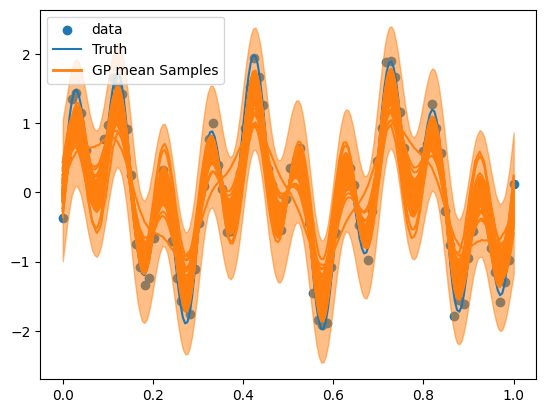
We can ask for two useful statistics as a product of a run now, the evidence which we can use to compare kernels, and the number of evaluations as a proxy for efficiency:
print(f"log evidence = {state.logZ:.2f}")
print(f"total evals = {final.inner_kernel_info.info.evals.sum()}")
log evidence = -136.53
total evals = 2252788
We can lastly plot the corner plot of the inferred frequencies and see if they mirror the known inserted values, However we see there is a problem in the parameterization of our model, we were fitting two degenerate basis functions and have ended up with 2 copies of the posterior.
from anesthetic import MCMCSamples
posterior_samples = sample(rng_key, final, 500)
MCMCSamples(posterior_samples["freq"], columns=[r"$\mu_{}$".format(i) for i in range(n_components)]).plot_2d()
| $\mu_0$ | $\mu_1$ | |
|---|---|---|
| $\mu_0$ | DiagonalAx... | OffDiagona... |
| $\mu_1$ | OffDiagona... | DiagonalAx... |
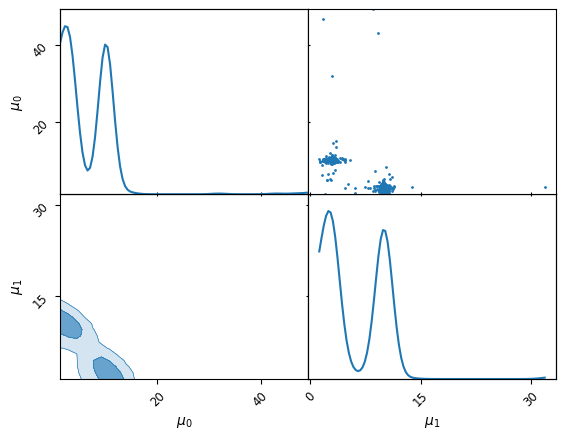
Label Switching (Forced identifiability)#
This is a good canvas to discuss how to approach the label switching problem. An illustration of this is visible in the corner plot of frequency where 2 identical modes are present. As we are fitting Gaussian basis functions, there is a \(N!\) degeneracy in the parameter space. For \(N=2\) this is not disasterous, but sampling will quickly become innefficient for higher numbers of basis functions.
There are a few options to address this, forced identifiability is a common transform to map the uniform hypercube over frequency to a simplex space, however this can have unpleasant effects on posterior geometry. In this example we will take a simpler effective approach of simply enforcing a sort in the covariance tuning. To do this we will overwrite the tuning function in the nss algorithm to account for this.
def sorted_stepper(x, n, t):
y = jax.tree.map(lambda x, n: x + t * n, x, n)
idx = jnp.argsort(y["freq"])
y["freq"] = jnp.take_along_axis(y["freq"], idx, -1)
y["weight"] = jnp.take_along_axis(y["weight"], idx, -1)
y["scale"] = jnp.take_along_axis(y["scale"], idx, -1)
return y
nested_sampler = blackjax.nss(
logprior_fn=lambda x: prior.log_prob(x).sum(),
loglikelihood_fn=loglikelihood,
num_delete=n_delete,
num_inner_steps=num_mcmc_steps,
stepper_fn = sorted_stepper
)
state, final = integrate(nested_sampler,rng_key, sort=True)
Dead points: 20000 dead points [00:18, 1080.97 dead points/s]
We can reuse our previous plotting and evaluation. We take more evaluations but achieve a similar functional form.
plot(rng_key,final)
print(f"log evidence = {state.logZ:.2f}")
print(f"total evals = {final.inner_kernel_info.info.evals.sum()}")
log evidence = -135.53
total evals = 2011645
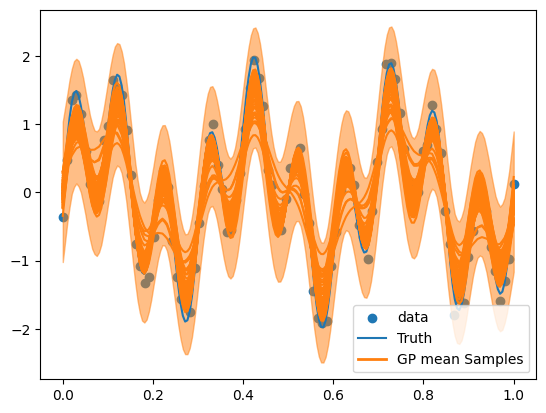
Importantly if we inspect the corner plot of the frequencies, it appears that we have succesfully identified a single mode with frequencies matching the input \(\mu_0=3.0,\mu_1=10.0\)
from anesthetic import MCMCSamples
posterior_samples = sample(rng_key, final, 500)
MCMCSamples(posterior_samples["freq"], columns=[r"$\mu_{}$".format(i) for i in range(n_components)]).plot_2d()
| $\mu_0$ | $\mu_1$ | |
|---|---|---|
| $\mu_0$ | DiagonalAx... | OffDiagona... |
| $\mu_1$ | OffDiagona... | DiagonalAx... |
